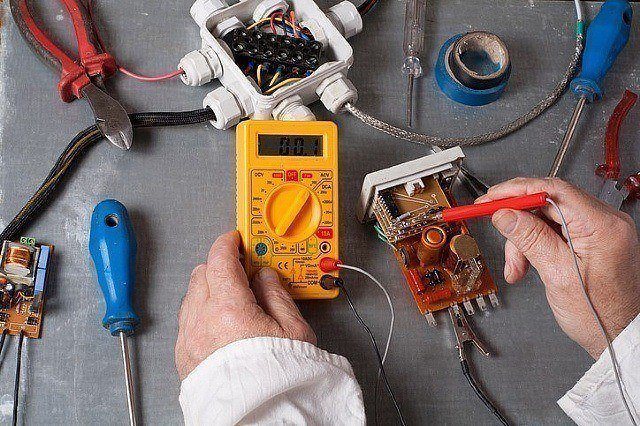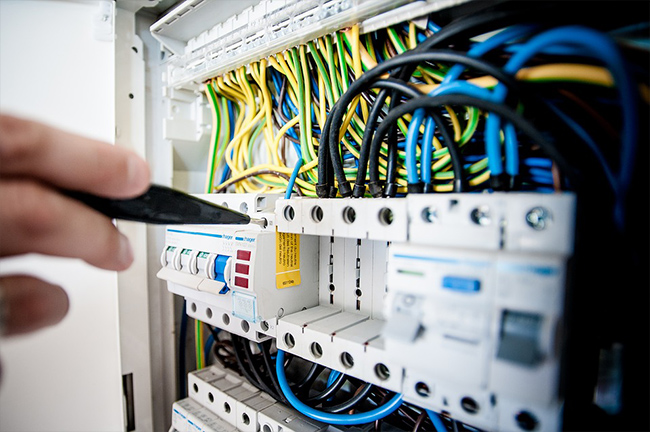Thinking of upgrading your electrical panel or service? Some things you should know.
What Is an Electrical Circuit Overload and How Can I Prevent It?
Electrical circuit overloads happen when more amperage is transferred across an electrical wire than the circuit can handle. For example, if you plug a laser printer into the same outlet as your computer tower, and the circuit doesn’t have enough amperage to support both devices, the circuit breaker will be tripped. A tripped circuit breaker cuts power to all devices using that circuit and brings productivity to a halt.
In order to avoid overloading your circuits and the possibility of electrical fires, outlets and wiring should be upgraded to have sufficient electrical capacity. Let the licensed professionals update and install the right circuits in your home or business today.

How to Update your Electrical System?
- The first step is to upgrade your panel by bringing more power from the utility to your home. You can replace the existing meter and circuit breakers to allow it to handle more power or replace an electrical panel or circuit breakers that are obsolete, damaged or dangerous. Doing this enables your electrical system to have more power to distribute without affecting the wiring inside the home.
- The second step includes adding extra circuits that can distribute the power to your rooms and appliances.
- Updating the system may also include adding new electrical outlets and replacing the used cable, old cable wires and receptacles.
Do I Need To Upgrade My Electrical Panel?
To learn about the capacity of your current breaker panel, look on the inside. There will be a tag, usually, on the door, that will list maximum voltage, current and power dissipation capability for the panel and busses. Most breaker boxes are 100, 150 or 200 amps. The average home typically requires 200 amp panels to fully operate all of your appliances and meet your electrical needs.
If you answered yes to our questions above, or find that your current panel doesn’t meet modern home electricity requirements, you may decide it’s time for an upgrade.
Tips for Upgrading the Electrical System in Your Home
The average cost of a complete wiring upgrade can range anywhere from $8,000 to $15,000 for medium to large homes (those from 1,500 to 3,000 square feet). This includes the opening of walls, installing the wiring, switches, and outlets, then closing the walls back up. The bill might deter you at first, but there are well-supported reasons to make the investment. This guide will offer essential tips when considering a complete electrical upgrade.
Consult With the Professionals
First things first. The level of electricity running throughout your home has the power to kill or injure you. According to the Electrical Safety Foundation International, there were 136 fatal and 2,210 non-fatal electrical injuries among electricians in the workplace in 2017. If there is a risk for trained professionals, then there is certainly a risk for the noble DIYer.
Professional licensed electricians will be well versed in compliance with the National Electrical Code (NEC) as well any local code requirements and restrictions. They can better help you devise the best plan for upgrading your electrical wiring. You can find a comprehensive breakdown of the NEC here.
GFCIs Are Crucial for a Safe Home
Ground fault circuit interrupters (GFCIs)—also known as residual current devices (RCDs)—are currently required by the NEC to be installed in outlets that run along your kitchen and bathroom countertops and in unfinished basements. This safety precaution is intended to protect against home electrocution in areas most likely to house electrical appliances that share close proximity to water.
These requirements were not always mandatory. If your home is older and has not had an electrical wiring upgrade, then you should consider bringing it up to code. Installing GFCIs is a task that requires electrical experience, so ensure you are well versed in what’s involved if you are considering doing the upgrade on your own. Keep in mind that this may require the installation of new circuit breakers in your electrical panel, a task best left to the professionals.
Upgrade Your Electrical Panel and Service
Older homes, those built more than 30 to 40 years ago, were designed to use an electrical service ranging from 30 to 50 amps of power. But today, a central air conditioning unit alone can require up to 200 amps to operate. The fact is clear that many older homes are simply not properly outfitted for the electrical demands of modern life.
An obsolete electric system is not only a frustration—as lights flicker and the breaker trips more frequently than is pleasant—but it is also a safety hazard. Between 2012 and 2016, electrical failures and malfunctions were the second leading cause of all reported house fires.
If you are experiencing any strange noises coming from your panel, burning odors near outlets, having circuit breaker trips more than once a month, or if your lights flicker and dim to compensate when you turn on the vacuum, you should seriously consider upgrading your electrical panel as part of your electrical wiring upgrade.
Consider Structured Wiring
Smart home technology has become commonplace as costs drop and tech advances. Keeping up with the trend, homeowners are increasingly connecting their flat-screen TVs, internet service, home security system, phones, and appliances through a fully-integrated smart home ecosystem. While many connected home devices connect wirelessly through Wi-Fi, many will continue to require hard-wired (and more secure) Ethernet connections. That’s why structured wiring and structured media enclosures have become standard fare in most new homes.
Properly outfitted with the right low-voltage wiring, networking cables, and high-capacity coaxial wiring, you can ensure connected devices are accessible from every room of the house as well as remotely. If you are interested in preparing your home for the connectivity of the future, you should consider running structured wiring throughout your home in tandem with a central structured media enclosure.

Getting the Right Size Service for your Home
The EC should quickly be able to tell you what size service you will need. Here are some examples for your reference:
- Home 1. The home is 2000 square feet, all gas appliances, with heating. This home would need a 60 amp service.
- Home 2. The home is 2000 square feet, all electric appliances, with heating. This home needs a minimum of 200 amps.
If you believe that your home needs a service upgrade, then you should know that cost difference between a 100, 200 and 400 amp size service panel are negligible. So, you need not worry about breaking the bank by installing a larger service panel.